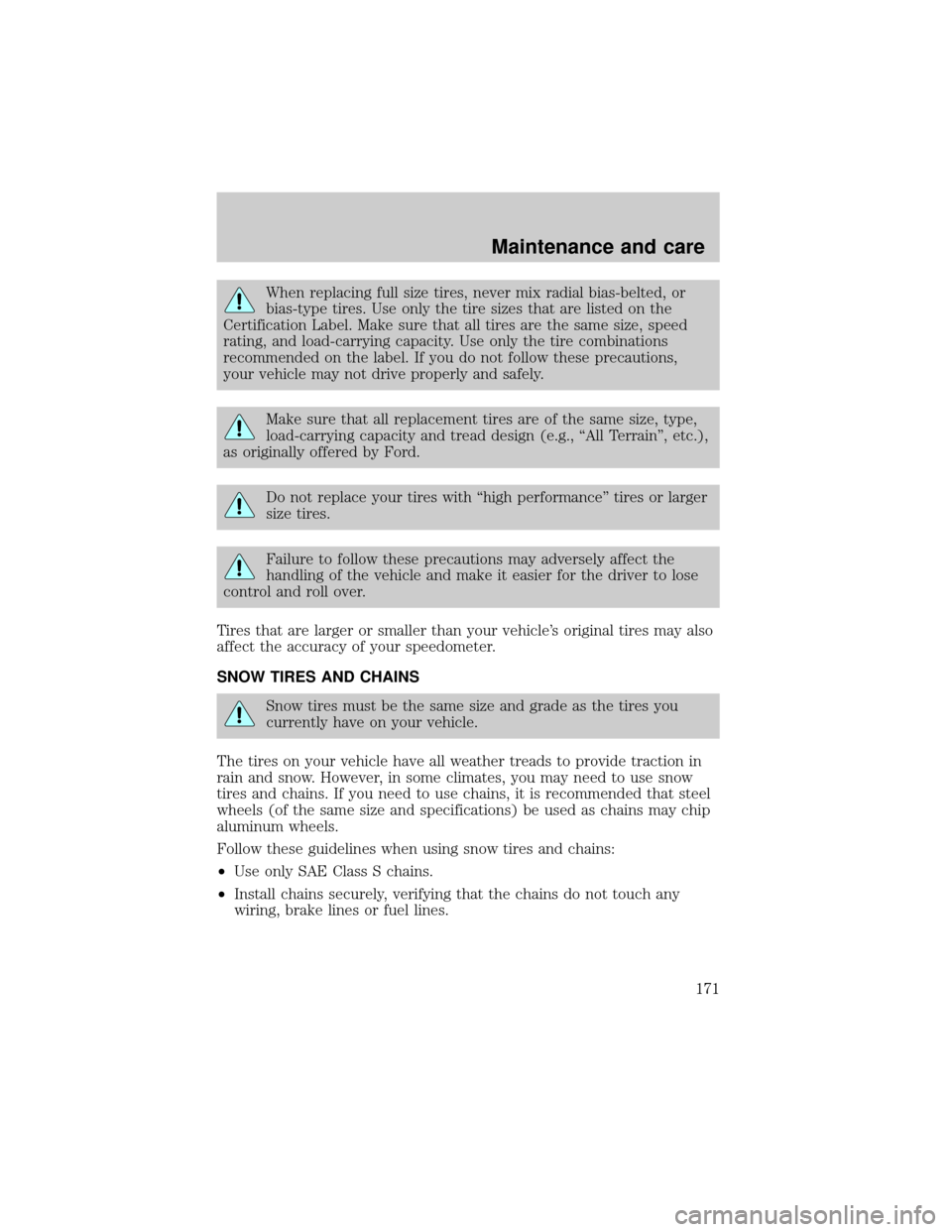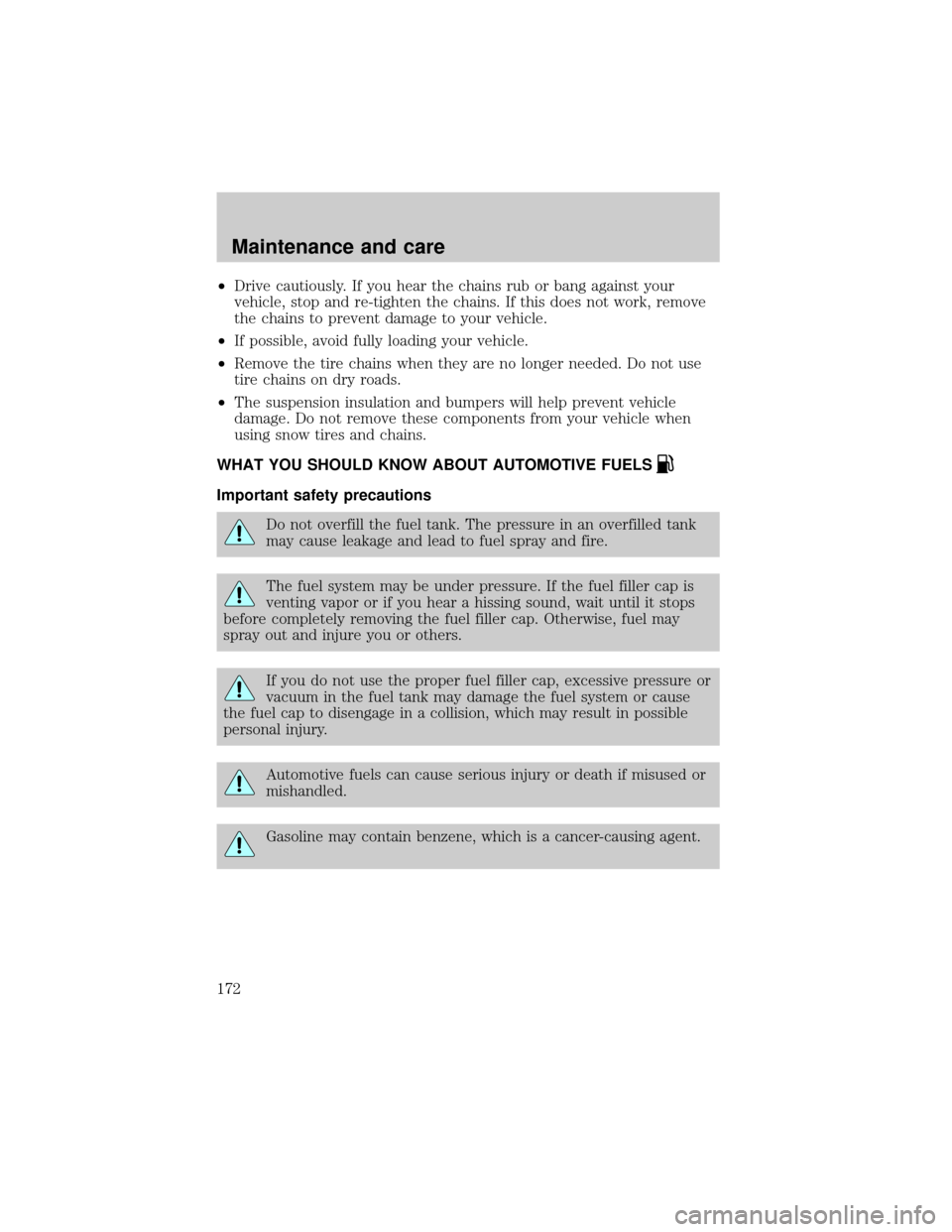snow chains FORD E SERIES 2001 4.G Owners Manual
[x] Cancel search | Manufacturer: FORD, Model Year: 2001, Model line: E SERIES, Model: FORD E SERIES 2001 4.GPages: 224, PDF Size: 1.82 MB
Page 171 of 224

When replacing full size tires, never mix radial bias-belted, or
bias-type tires. Use only the tire sizes that are listed on the
Certification Label. Make sure that all tires are the same size, speed
rating, and load-carrying capacity. Use only the tire combinations
recommended on the label. If you do not follow these precautions,
your vehicle may not drive properly and safely.
Make sure that all replacement tires are of the same size, type,
load-carrying capacity and tread design (e.g., ªAll Terrainº, etc.),
as originally offered by Ford.
Do not replace your tires with ªhigh performanceº tires or larger
size tires.
Failure to follow these precautions may adversely affect the
handling of the vehicle and make it easier for the driver to lose
control and roll over.
Tires that are larger or smaller than your vehicle's original tires may also
affect the accuracy of your speedometer.
SNOW TIRES AND CHAINS
Snow tires must be the same size and grade as the tires you
currently have on your vehicle.
The tires on your vehicle have all weather treads to provide traction in
rain and snow. However, in some climates, you may need to use snow
tires and chains. If you need to use chains, it is recommended that steel
wheels (of the same size and specifications) be used as chains may chip
aluminum wheels.
Follow these guidelines when using snow tires and chains:
²Use only SAE Class S chains.
²Install chains securely, verifying that the chains do not touch any
wiring, brake lines or fuel lines.
Maintenance and care
171
Page 172 of 224

²Drive cautiously. If you hear the chains rub or bang against your
vehicle, stop and re-tighten the chains. If this does not work, remove
the chains to prevent damage to your vehicle.
²If possible, avoid fully loading your vehicle.
²Remove the tire chains when they are no longer needed. Do not use
tire chains on dry roads.
²The suspension insulation and bumpers will help prevent vehicle
damage. Do not remove these components from your vehicle when
using snow tires and chains.
WHAT YOU SHOULD KNOW ABOUT AUTOMOTIVE FUELS
Important safety precautions
Do not overfill the fuel tank. The pressure in an overfilled tank
may cause leakage and lead to fuel spray and fire.
The fuel system may be under pressure. If the fuel filler cap is
venting vapor or if you hear a hissing sound, wait until it stops
before completely removing the fuel filler cap. Otherwise, fuel may
spray out and injure you or others.
If you do not use the proper fuel filler cap, excessive pressure or
vacuum in the fuel tank may damage the fuel system or cause
the fuel cap to disengage in a collision, which may result in possible
personal injury.
Automotive fuels can cause serious injury or death if misused or
mishandled.
Gasoline may contain benzene, which is a cancer-causing agent.
Maintenance and care
172
Page 220 of 224

P
Panic alarm feature, remote
entry system ................................63
Parking brake ............................103
Parts (see Motorcraft parts) ....192
Power distribution box
(see Fuses) ...............................128
Power door locks ........................61
Power steering ..........................104
fluid, checking and adding ....157
fluid, refill capacity ................193
fluid, specifications .........196, 199
Preparing to
drive your vehicle .....................105
R
Radio ............................................27
Relays ................................124, 131
Remote entry system ...........62±63
illuminated entry ......................65
locking/unlocking doors ...........63
panic alarm ...............................63
replacement/additional
transmitters ...............................65
replacing the batteries .............64
S
Safety belts (see
Safety restraints) ............14, 73±77
Safety defects, reporting ..........215
Safety restraints ....................73±77
belt minder ...............................79
cleaning the safety belts ..82, 191
extension assembly ..................78
for adults .............................74±76for children .........................87±88
lap belt ......................................78
warning light
and chime ......................12±13, 79
Safety seats for children ............89
Seat belts
(see Safety restraints) ...............73
Seats ............................................66
child safety seats ......................89
Servicing your vehicle ..............144
Spark plugs,
specifications .....................192, 199
Special notice ................................4
ambulance conversions ..............4
diesel-powered vehicles .............5
utility-type vehicles ....................4
Specification chart,
lubricants ...........................196, 199
Speed control ..............................50
Speedometer ...............................14
Starting your vehicle ..........98, 100
jump starting ..........................138
Steering wheel
tilting .........................................54
T
Tires ...........................131, 167±169
changing ..........................131, 133
checking the pressure ............169
replacing ..........................134, 170
rotating ....................................169
snow tires and chains ............171
tire grades ...............................168
treadwear ................................168
Towing .......................................112
recreational towing .................119
Index
220